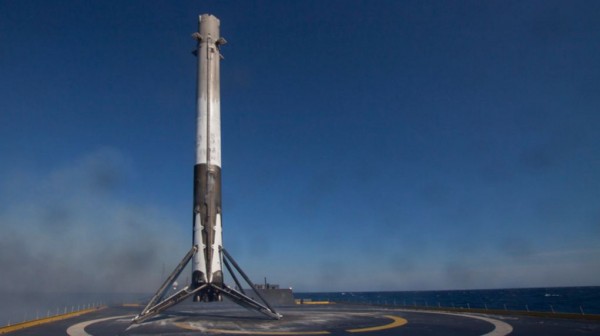By Arthur Dominic J. Villasanta , | April 03, 2017

Falcon 9 first stage after landing.
Elon Musk is predicting it's possible to make the cost of launching a rocket into space so cheap because of re-using the first stage booster that 10,000 launches a year will be possible in the future using just 100 SpaceX launch vehicles.
And he also revealed SpaceX's new goal is to begin re-using rockets within 24 hours of landing. The only interruption will be to refuel and inspect the first stage booster.
Like Us on Facebook
"At this point I'm highly confident that it's possible to achieve at least 100-fold reduction in the cost of space access," Musk said after watching the first-ever takeoff of a re-used Falcon 9 Full Thrust booster last March 31.
While Musk gave no exact figures, this figure (if it refers only to launch cost) will mean that the current cost of launching a Falcon 9 into low Earth orbit (LEO) -- which comes to some $60 million per launch -- will one day be whittled down to just $600,000.
One industry expert predicted that SpaceX will offer a "service-to-orbit" in the next two years, and customers won't care if the SpaceX launch vehicle is new or re-used.
SpaceX's Falcon 9 Full Thrust launch vehicle is the only one of its kind in the world that can pull of a landing and re-launch of a first stage booster. Falcon 9 is a family of two-stage-to-orbit launch vehicles with Falcon 9 Full Thrust being its newest model.
Falcon 9 Full Thrust can lift payloads of up to 22,800 kilograms to LEO and up to 8,300 kilograms to geostationary transfer orbit (GTO).
Industry sources said SpaceX's plan for its fleet of reused boosters is a grand gamble. They estimate fleet of 10 reusable SpaceX first stage boosters each flying only once a month will result in 120 flights a year.
A fleet of 30 reusable first stage boosters each flying once per week will complete 1,500 flights a year. A fleet of 100 reusable first stage boosters each flying twice per week will mean 10,000 flights a year.
A fleet of 200 reusable first stage boosters each flying once a day will amount to 70,000 flights a year.
-
Use of Coronavirus Pandemic Drones Raises Privacy Concerns: Drones Spread Fear, Local Officials Say

-
Coronavirus Hampers The Delivery Of Lockheed Martin F-35 Stealth Fighters For 2020

-
Instagram Speeds Up Plans to Add Account Memorialization Feature Due to COVID-19 Deaths

-
NASA: Perseverance Plans to Bring 'Mars Rock' to Earth in 2031

-
600 Dead And 3,000 In The Hospital as Iranians Believed Drinking High-Concentrations of Alcohol Can Cure The Coronavirus

-
600 Dead And 3,000 In The Hospital as Iranians Believed Drinking High-Concentrations of Alcohol Can Cure The Coronavirus

-
COVID-19: Doctors, Nurses Use Virtual Reality to Learn New Skills in Treating Coronavirus Patients









